From the Field: Bill Buck in Cape Horn, Day 3
Posted in Bill Buck, From the Field, Science on February 2 2012, by William R. Buck
January 19, 2012; Chile, unnamed sound on north-central coast of Isla Hoste, approximately 55º00’S, 69º12’W
As the sky slowly darkened last night, we passed site after site that we all thought looked like great collecting localities. Today we begin finding out.
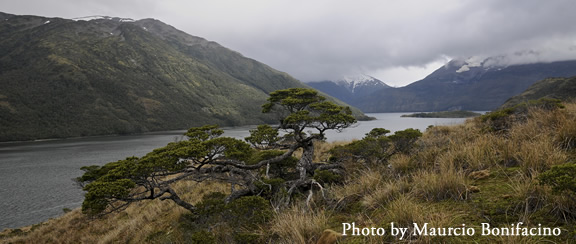
For our first collecting site, we have headed as far east as we will go on this leg of the trip. We are anchored in one of the innumerable, unnamed sounds that dot this area, on the north-central coast of Isla Hoste. Between Isla Hoste and Isla Gordon lies the Beagle Channel (named for Charles Darwin’s ship, the HMS Beagle), and we are planning to bounce back and forth across the southwest arm of the Channel.
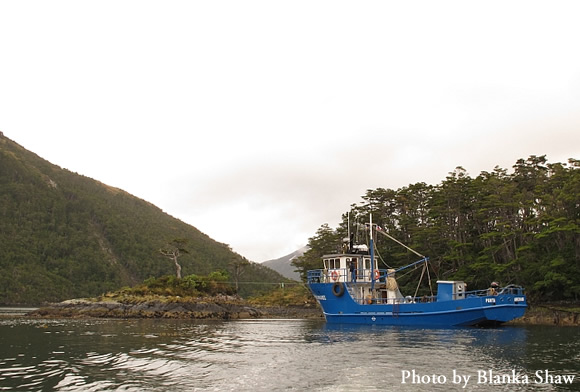
But, after just a short time at our very first site, I am already reevaluating this plan. We passed such phenomenal-looking localities on our way here, that the sites with vegetation similar to those we surveyed extensively last year suddenly don’t seem so interesting. Of course, this is all relative, because for those of our group who have never experienced Magellanic tundra, this habitat is still fascinating. However, the lure of one glacier after another–each one producing a high humidity environment and the possibility of a diversity of epiphytic bryophytes–has lead me to decide that we will skip some of the sites similar to ones we collected at last year so that we have more time at the special habitats in this year’s area. In addition there is an almost universal request that we collect on Isla Darwin. In order to accomplish this, we need to prune another site.
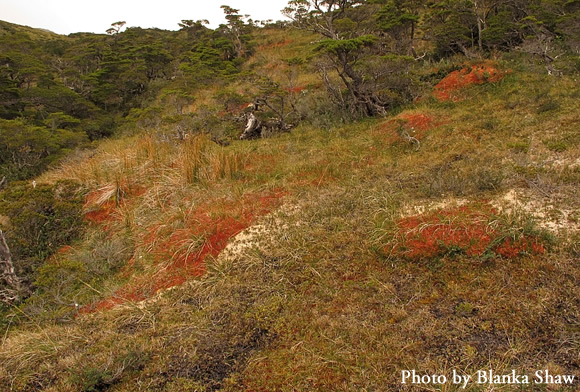
For today, though, we are sticking to our original plan. As we ate lunch, the ship moved to an unnamed sound on Isla Gordon, not too far from the island’s eastern tip. The attraction here is a large, multi-tiered waterfall. I started near the base and worked upstream. The localized increase in humidity wherever there was whitewater lead to a direct increase in moss diversity. However, once I got near the base of the falls it became impossible to collect immediately alongside the water because the cascading stream was at the bottom of a steep ravine.
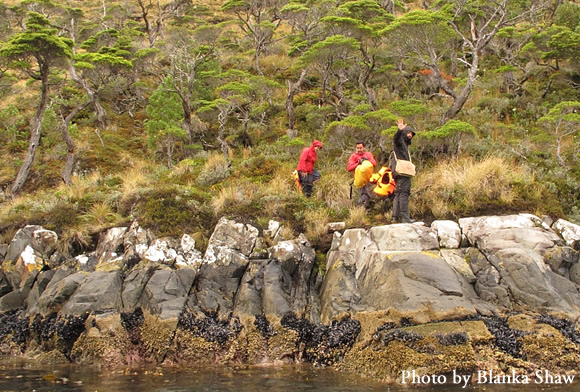
I moved from the stream bank into the forest and started up the steep ascent. In no time at all I was cursing the extensive mats of hornworts that carpet the forest floor. These plants are naturally slimy, acting as a lubricant underfoot, so on the steep slope upwards, for each step forward I would often slide two steps back downhill. I wasn’t even able to stand still! Nevertheless, the diversity of mosses more than compensated for the physical struggle.
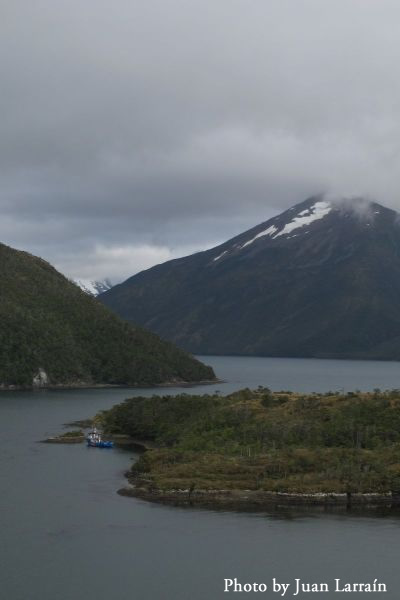
In time I reached the highest point I thought I should ascend to in order that I might still be able to spend some time in the swamp back down at the base. It was at this point that I began to truly appreciate my new rain gear. Last year I had a pair of supposedly waterproof bib overalls; unfortunately I soon learned that while sitting on the saturated ground they weren’t actually all that waterproof after all.
So, this year I invested in a pair of heavy duty, essentially all rubber bib overalls. At one point the slope–at this point mostly grass–became so steep that it was hard to keep from sliding downhill. So, I just sat down and started sliding. It was as good as any commercial water park! I slid down at least 25 meters before finally using my feet as brakes. It’s probably just as well that no one else was around because I was laughing so hard that I’m sure my colleagues would have probably thought I had finally cracked. What took over an hour to climb took only a few minutes to descend. In the end, the hornworts facilitated my trip rather than frustrated it.
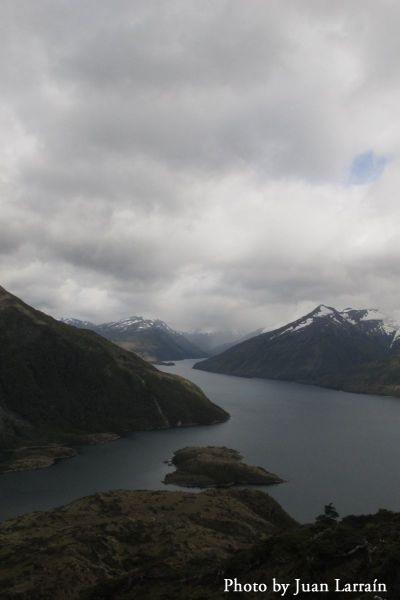
Our first day in the field was a very long day. We started our fieldwork at about 8:30 a.m., breaking for lunch on the ship around 1:00 p.m. We were in the field at our second location until 7 p.m. Dinner was eaten shortly after we got back to the ship, and then we had to deal with all the specimens we had collected. Because it was the first day, everyone collected everything. Xiaolan alone collected about 200 liverworts! I modestly hauled in only 130 collections. Each specimen has to be numbered and put on the dryer. By the time I finished with mine it was well after 10 p.m. and I was exhausted. I staggered into my bunk at 11 p.m. and was the first one to bed.
Ed. note: NYBG scientist and Mary Flagler Cary Curator of Botany, Bill Buck is currently on expedition to the islands off Cape Horn, the southernmost point in South America, to study mosses and lichens. Follow his journeys on Plant Talk.
Bill Buck’s Previous Reports From the Field:
2012
January 18, 2012; Canal O’Brien, just south of Isla O’Brien, 54º55?S, 70º35?W
January 17, 2012; Punta Arenas, Chile
2011
July 15, 2011; Hobart, Tasmania, Australia
July 14, 2011; Pyengana, Tasmania, Australia
July 13, 2011; Weldborough, Tasmania, Australia
July 12, 2011; Hobart, Tasmania, Australia
July 11, 2011; Hobart, Tasmania, Australia
February 8, 2011; Punta Arenas, Chile
February 5, 2011, unnamed sound northwest of Isla Georgiana
February 4, 2011, unnamed sound directly east of Seno Mama, Chile
February 2, 2011, Seno Courtenay, northern arm, Chile
February 1, 2011, Seno Courtenay, Chile
January 31, 2011, Canal between Isla Georgiana and Isla Clementina,, Chile
January 30, 2011, Unnamed sound on south side of Brecknock Peninsula, NW of Isla Georgiana, Chile
January 29, 2011, Isla Aguirre, Seno Quo Vadis, Chile
January 26, 2011, Punta Arenas, Chile
January 24, 2011, Seno Chasco, just north of isthmus to Brecknock Peninsula, Chile
January 23, 2011, Isla Grande de la Tierra del Fuego, Puerto Consuelo, Seno Chasco, Chile
January 22, 2011, Isla Grande de la Tierra del Fuego, Seno Brujo, Chile
January 21, 2011, Isla Grande de la Tierra del Fuego, Seno Brujo, Chile
January 20, 2011, Isla Grande de la Tierra del Fuego, Seno Bluff, Chile

